Five years of progress
In 2024, we celebrated Findata’s five-year journey. Over the past five years, we have developed Finland’s secondary use services, improving both the accessibility and security of social and health data. By the end of last year, we had received a total of 1,521 applications and issued 1,418 decisions.
Alongside our daily operations, we actively prepared in 2024 for the European Health Data Space (EHDS) regulation, which will create new opportunities for the use of health data in research, development, and innovation. Finland is well positioned in this transition, having more than five years of experience with a one-stop-shop model for secondary use of social and health data.
Together with data controllers and other partners, we have built a robust infrastructure for data processing and access procedures. Finland now has ten EHDS-compliant secure data processing environments, with approximately 5,000 users and 1,100 ongoing research projects.
Finland is recognised as a frontrunner in secondary use, serving as an example for other EU countries. In 2024, we chaired the EHDS Community of Practice for future data permit authorities and actively contributed to the development of common practices through initiatives such as the European Commission’s TEHDAS project and the Nordic VALO project.
Finland has strong potential to lead the way in implementing EHDS. Through the FinHITS project, we are strengthening the ICT infrastructure and services for secondary use to ensure a seamless integration into the EHDS.

Issues related to data protection and personal data management have become increasingly important. Ultimately, it is about finding a balance between protecting citizens’ privacy and enabling the free use of health data for research.
Johanna Seppänen, PhD, Director
Alongside EU developments, Finland also began the process of revising its national secondary use legislation last year. We have actively shared our insights on necessary legal improvements, emphasising the importance of clearer regulation. In particular, it is essential to ensure the independence and impartiality of the permit authority and to improve access to individual-level data for research purposes.
Data protection and individuals’ control over their own data have become increasingly important issues. Ultimately, the goal is to strike a balance between safeguarding citizens’ privacy and enabling the free use of health data for research. Open, fact-based discussion is key to establishing common ground.
In 2025, our goal remains the same: to promote the responsible and efficient use of health data in research and evidence-based decision-making. Together with our partners, we continue to develop solutions that enable the secure, effective, and seamless use of health data.
Johanna Seppänen, PhD, Director

2024 in figures
Compared to last year, the number of applications increased by 7 percent and the number of decisions decreased slightly by 3 percent. The number of decisions still exceeded the number of applications received.
58% amendment applications
34% data permit applications
8% data requests
94% positive
6% lapsed
<1% negative
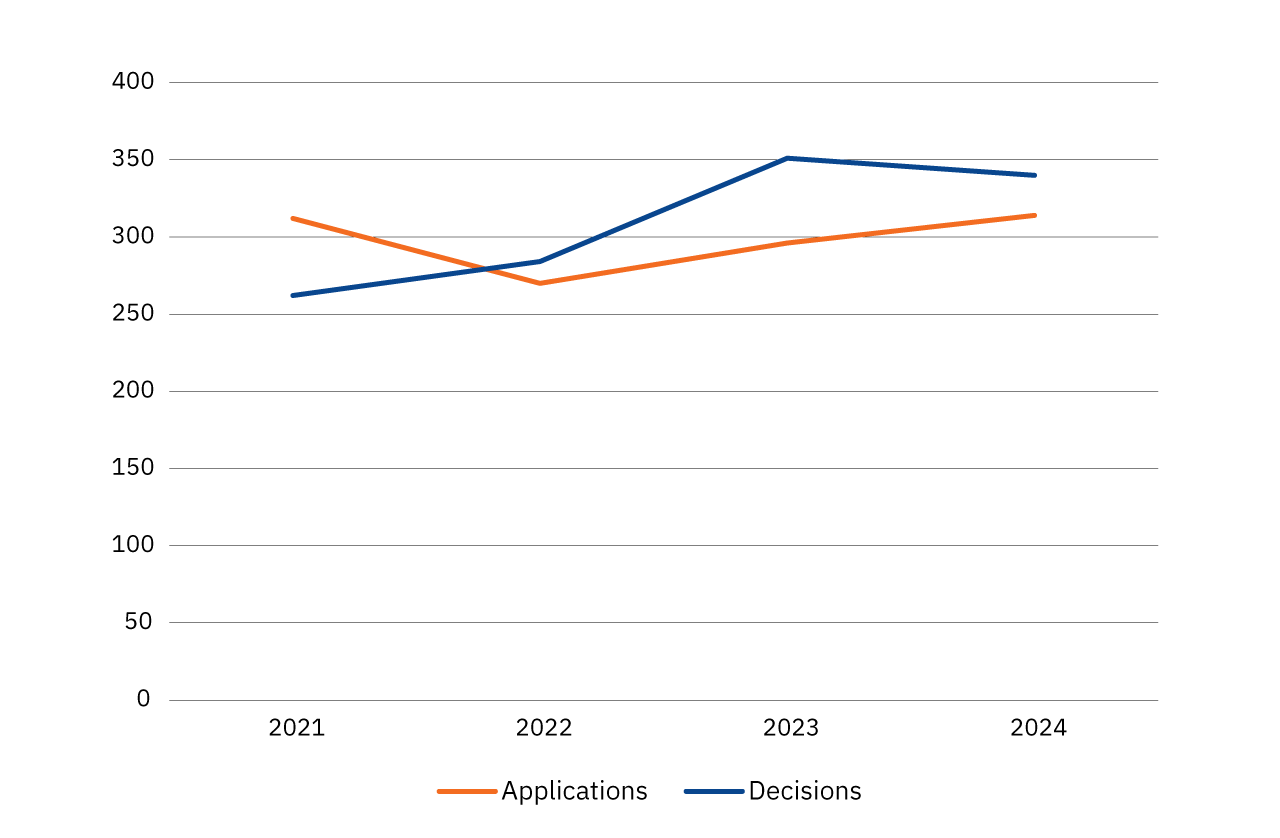
Processing times for data permit applications continued to vary widely. The fastest decision was made in 10 days, but the median processing time increased from 71 days to 82 days. On average, data permit applications spent about one-third of their processing time at Findata, while the remaining time was spent waiting for information from the customer or data controllers.
Most applications for amendment permits were processed very quickly, with a median processing time of six days.
Decisions by type of permit
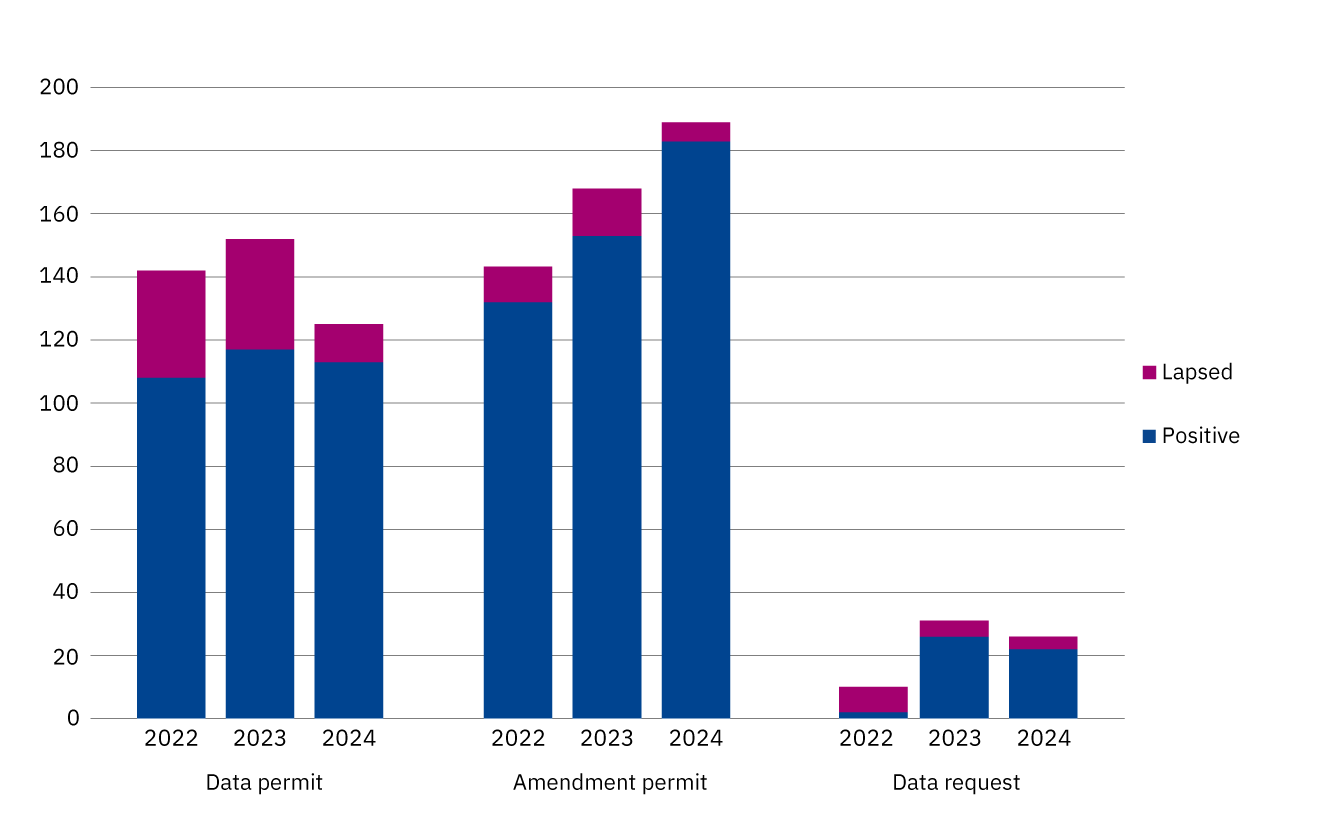
Last year, we issued 113 positive data permit decisions. On average, one permit covered data from more than four different data controllers. The most extensive permit involved data from 23 data controllers, while the smallest covered just one. In total, we granted data permits for datasets from 62 different data controllers.
We issued a record number of data permit amendments, totalling 183. This represents an increase of approximately 20% compared to the previous year. Amendment decisions accounted for nearly 60% of all decisions made.
Of the amendment decisions, 70% concerned changes to data processors, while just under one-fifth related to extending the validity of a permit. Around 15% of the decisions involved adding variables or data or extending the extraction period, and approximately 5% were related to changing the processing environment.
The number of data requests remained at the previous year’s level. Over the year, we issued a total of 22 data request decisions, four fewer than in 2023. On average, each decision covered data from just under two data controllers.
The share of lapsed decisions decreased to six percent last year, reflecting the continuous development of our advisory services and guidance. The number of lapsed decisions has been declining in previous years as well, from 33 percent in the first year to 15 percent the year before last.
Purpose of use of the permits and data requests granted
The vast majority of the permits, 92%, were granted for scientific research.
As in previous years, only a few decisions were made for other purposes, with the highest share (6%) granted for statistical use.
However, the number of permits issued for development and innovation activities increased significantly compared to the previous year: seven decisions were made last year, up from just two the year before.
No permit or data request decisions were issued for education, social and healthcare authority guidance, or supervision.
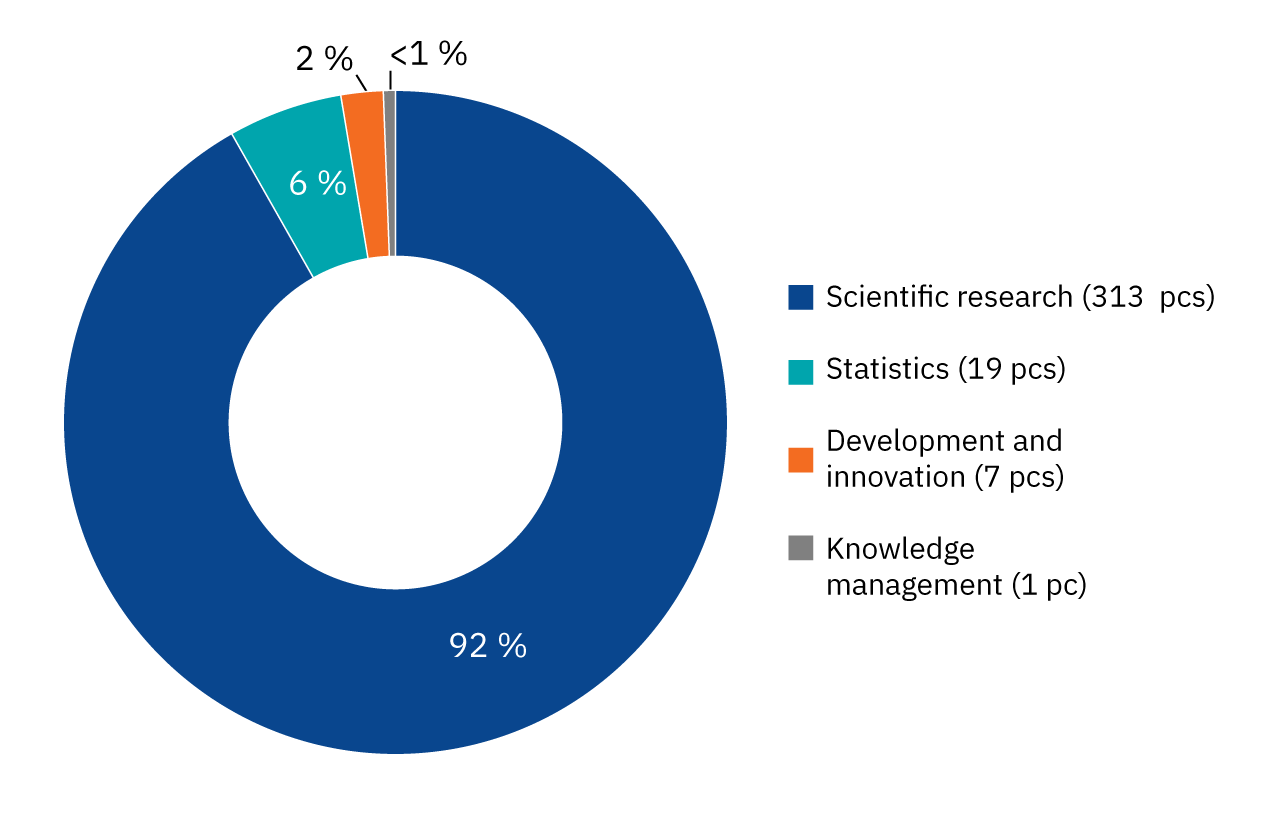
See all the permits granted by us and the permit holders here: Permits issued
Applicants and their backgrounds
Although the number of amendment decisions increased significantly, the share of amendment applications decreased from 58% last year to 50%. Meanwhile, the share of new data permit applications rose from 29% to 44%. The proportion of data requests concerning statistical data declined from 13% to 8%.
There were also changes in the distribution of applicants’ backgrounds. The share of private sector applicants returned to its previous level after increasing last year.
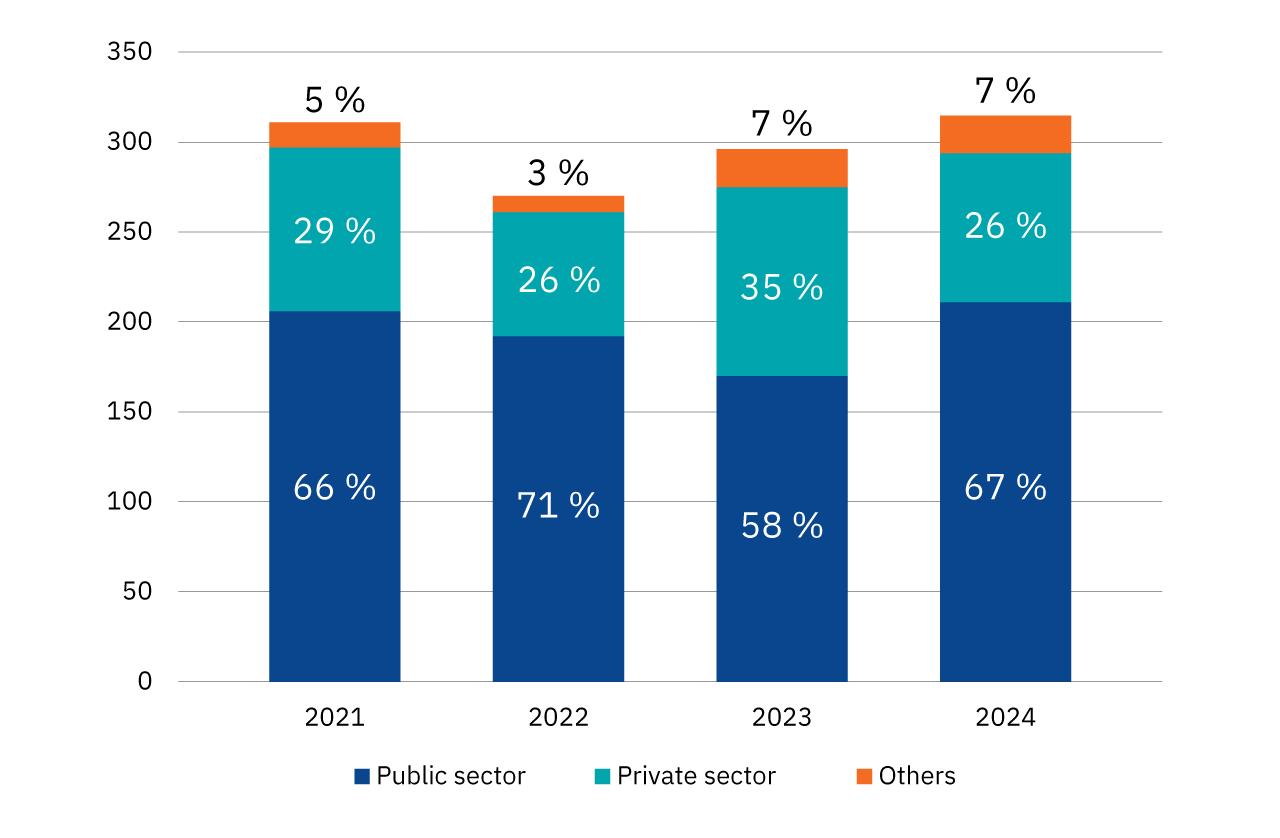
The public sector accounted for 67% of applications submitted last year, while the private sector made up 26%. In 2023, the corresponding figures were 58% and 35%.
The ‘others’ category mainly comprises customers from the third sector and those who have requested data as private individuals.
We categorize the background of the applicants according to the main applicant. Some of the permits have been granted to projects or consortia that involve not only the main applicant but also other sectors.
Most requested controllers and organisations
Continuing the trend from previous years, in 2024 the demand was greatest for national registers.
In 85% of applications, data was requested from the registers of the three most sought-after data controllers – Finnish Institute for Health and Welfare (THL), the Social Insurance Institution of Finland Kela and/or Statistics Finland. The next most requested datasets came from HUS, the Digital and Population Data Services Agency, and the Wellbeing Services County of Southwest Finland.
| Popularity | Controller | Number of applications 2021 | Number of applications 2022 | Number of applications 2023 | Number of applications 2024 |
|---|---|---|---|---|---|
| 1. | Finnish Institute for Health and Welfare (THL) | 113 | 110 | 116 | 113 |
| 2. | The Social Insurance Institution of Finland Kela | 66 | 76 | 61 | 86 |
| 3. | Statistics Finland | 51 | 64 | 45 | 70 |
| 4. | HUS | 27 | 43 | 16 | 38 |
| 5. | Digital and Population Information Agency (DVV) | 29 | 42 | 25 | 35 |
| 6. | The Wellbeing Services County of Southwest Finland | 27 | 33 | 14 | 34 |
| 7. | Cancer Society of Finland | 7 | 12 | 12 | 26 |
| 8. | The Wellbeing Services County of Pirkanmaa | 14 | 28 | 12 | 25 |
| 9. | Finnish Centre for Pensions (ETK) | 15 | 15 | 17 | 21 |
| 10. | The Wellbeing Services County of North Ostrobothnia | 8 | 23 | 9 | 21 |
Data sampling requests and deliveries
13 requests/week
13 sets/week
Around 4 datasets/package
The number of data sets remained at the previous year’s level overall, but the number of individual datasets per delivered data package decreased by 40 percent.
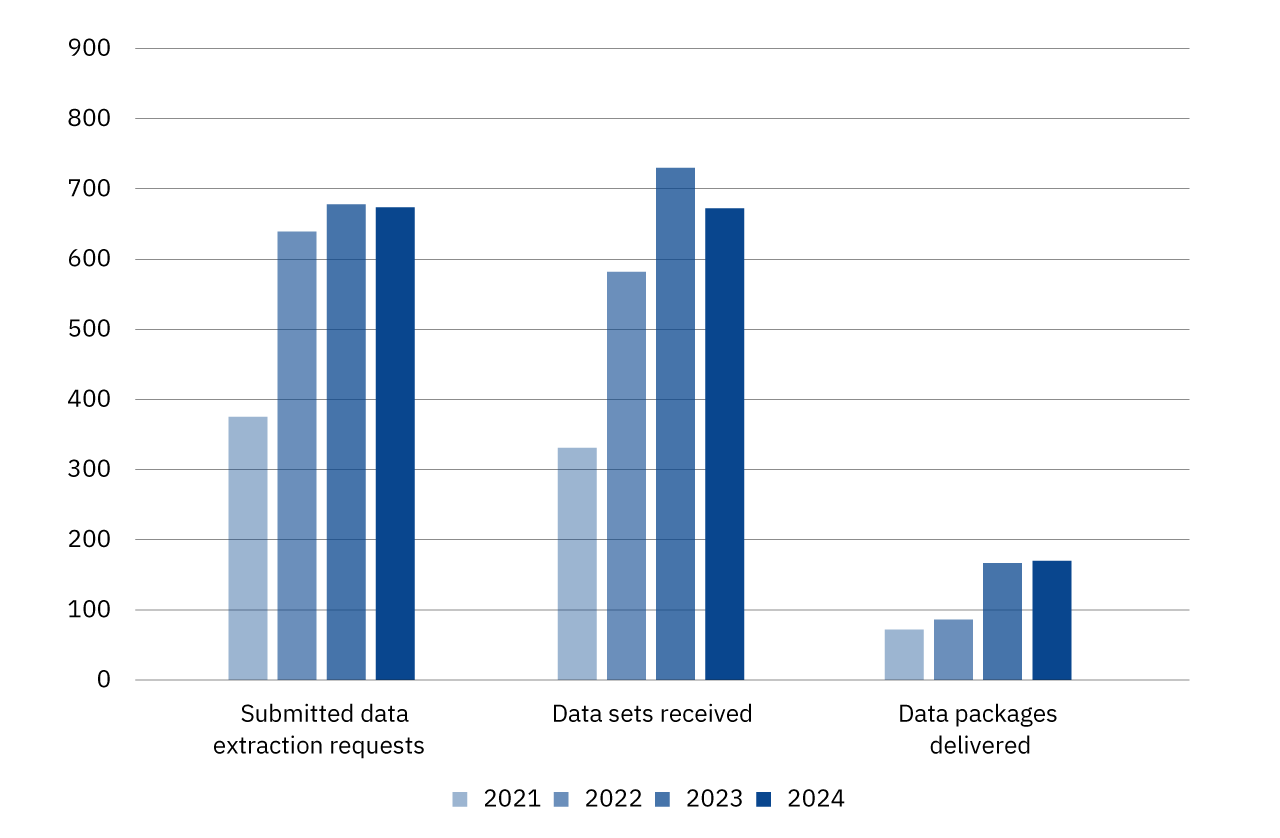
The volume of the verification of dataset anonymity continued to grow. In 2024, we verified the anonymity of results from Kapseli a total of 1,061 times, up from 747 times in 2023. Additionally, results brought in from other environments were verified 140 times.
In 80% of cases, the results were approved as they were. In 20% of verifications, issues were identified in the results’ content, about the same that the 19% recorded the previous year. The most common issue was the presentation of small frequency data.
Collaboration on reducing extraction errors and related costs continued with 11 data controllers. This has improved the resolution of errors, but further efforts are needed to prevent errors proactively.
We also continued supporting data descriptions by providing training for data controllers and developing tools such as the Data resources editor and Data resource catalogue.
GDPR requests
In summer 2024, Yle reported on a ready-made dataset based on registry data from THL and the University of Helsinki’s FinRegistry research project, for which data access permits can be applied through Findata.
The news sparked discussion about the secondary use of social and healthcare data and citizens’ data protection. This led to a record number of access and objection requests under the General Data Protection Regulation (GDPR).
The processing of these requests was improved to meet the increased demand, but this alone is not sufficient. Finland needs a centralised national solution for implementing GDPR rights in the secondary use of social and healthcare data.
In 2024, we received 1,703 objections to data processing and 503 requests for access to data.
Between 2020 and 2023, we had received a total of 264 similar requests, meaning that last year alone, the number of requests was more than seven times higher than during our entire previous operations.
The significant increase in citizen requests temporarily caused delays in Findata’s other statutory services, particularly in data processing.
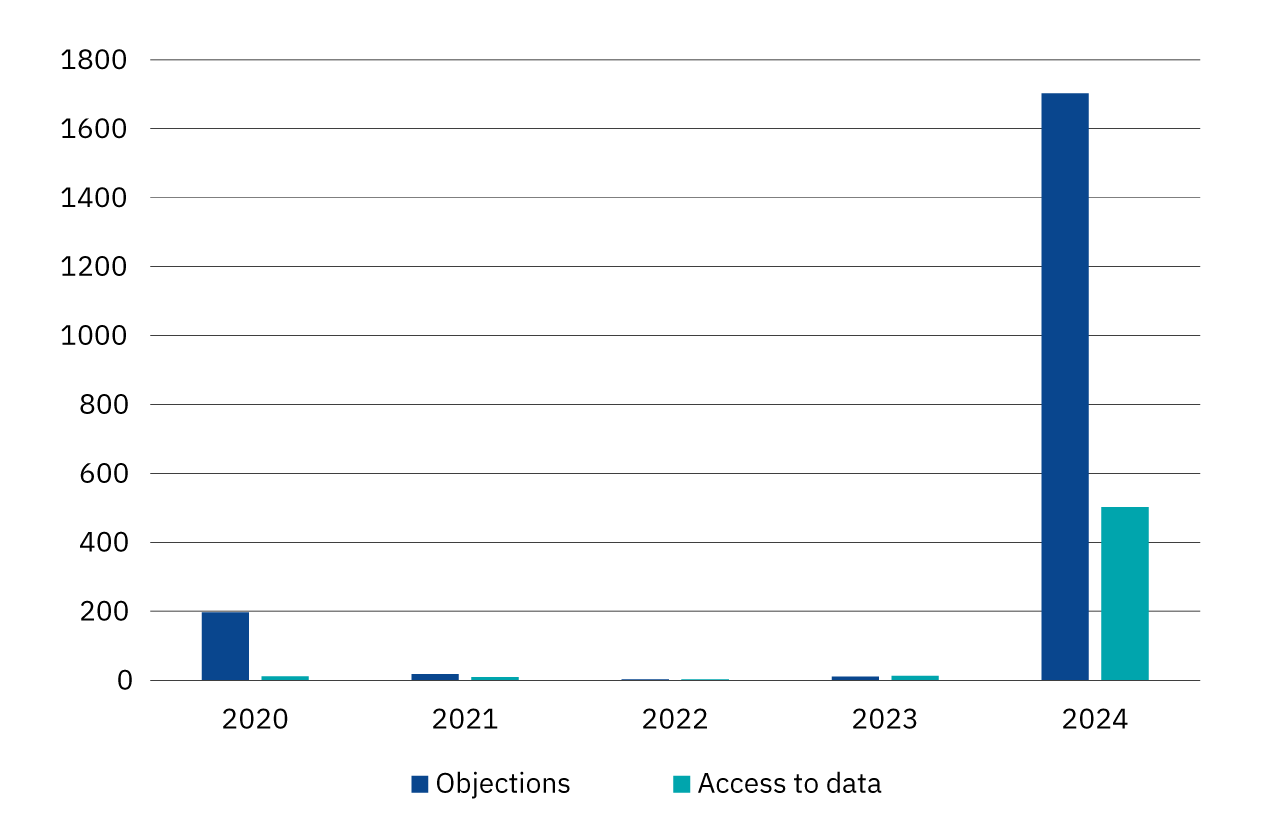
Read more: Your data rights

Kapseli®
The number of Kapseli processing environments increased by 6 percent, while the number of users decreased by 9 percent.
The number of Findata’s secure Kapseli environments continued to grow, but the number of registered users decreased.
At the end of 2024, there were 147 active Kapseli environments with a total of 875 registered users.
The average number of users per Kapseli initially increased from five to eight but returned to six last year.
On average, 20 new Kapseli orders or modifications were made each month, equivalent to one per business day.
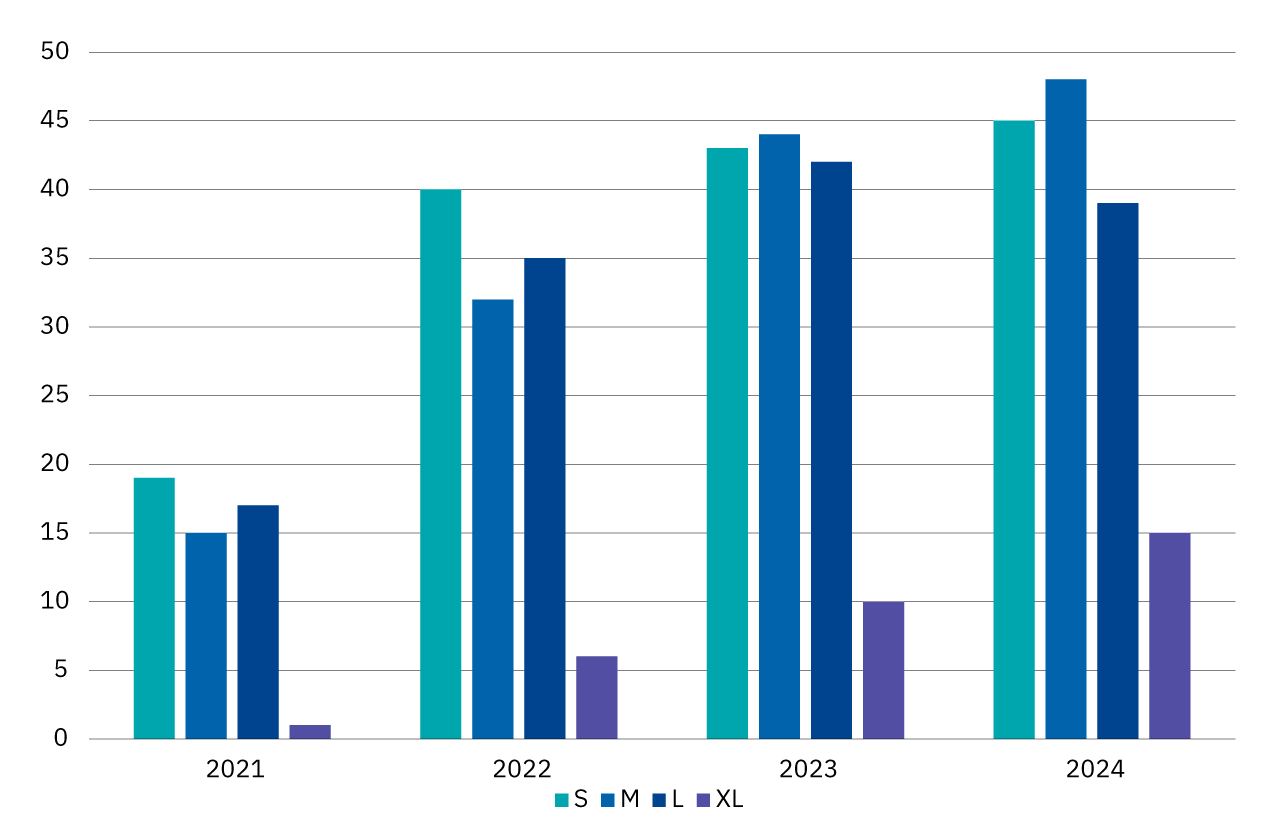

Distribution of costs
A total of approximately EUR 2.2 million was paid for the secondary use of social and health data through Findata in 2024.
Data processing EUR 373 000
– EUR 80 000 (-11%) compared to 2023
+ EUR 340 000 (+26 %) compared to 2023
The figure includes Findata’s decision fees for new data permits, amendment permits and data requests, Findata’s data processing fees and extraction costs charged to customers by data controllers.
On average, 27 percent of the total fees collected from customers were made up of Findata’s decision fee and data processing costs. These processing costs arise from the combination of datasets collected from data controllers, as well as pseudonymisation or anonymisation and delivery to a secure environment. The decrease in fees can be attributed to reduced permit fees for researcher-driven studies and more efficient data processing.
Correspondingly, on average, 73 percent of the customer’s invoice consisted of data extraction costs charged by the data controllers.
For the use of Kapseli, Findata’s customers paid a total of €451,000, which is €80,000 (+25%) more than in 2023.
Findata’s decision and data processing fees and data controller’s extraction costs in 2024
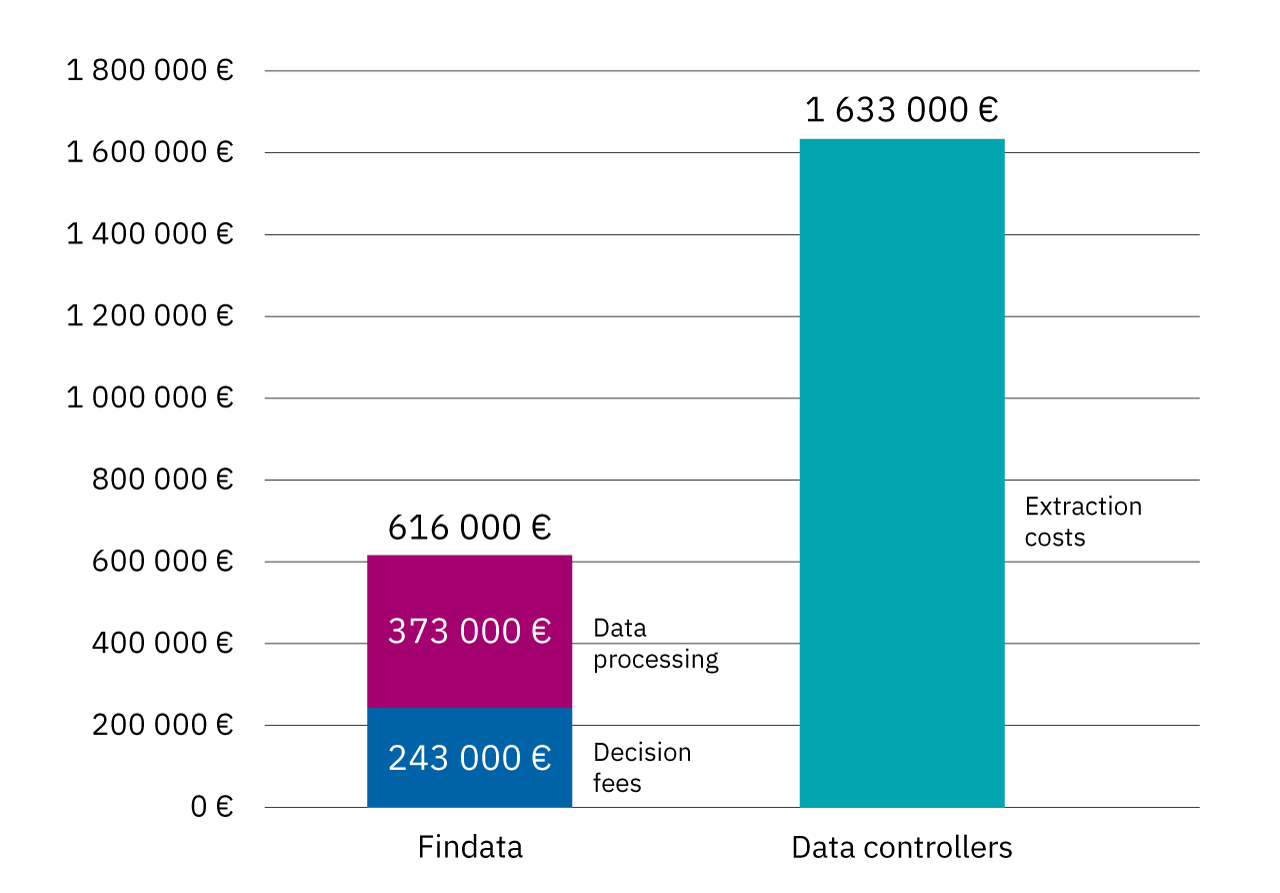

FinHITS – Strengthening Finnish Health Data ICT for Secondary Use
In 2024, the EU-funded FinHITS project by Findata moved forward at a strong pace.
At the beginning of the year, we gathered feedback from our stakeholders on our services through surveys and workshops. The project’s launch event, held in April, brought together over a hundred secondary use experts to discuss the future of secondary use services and the changes introduced by the EHDS.
Throughout the year, we met with several national and international stakeholders to discuss collaboration, the implementation of the EHDS, and the development of secondary use services. Using the feedback we collected, we developed service improvement plans, which we presented during a webinar held in November.
The project also delivered its first results last year. Following the pilot, the appointment booking service, which offers personalised advice via remote connection, received positive feedback from customers. Half of those who used the service provided feedback, and the Net Promoter Score (NPS) for the service was impressively high: 93 (scale: -100 to 100). Additionally, we began hosting English-language application clinics for international customers to provide them with even better advisory services.
Alongside the service desk improvements, we selected the technical solution for the E-service, and the implementation work is currently underway. Development work on other work packages is also in full swing.

Communication and stakeholders
In 2024, we expanded our international communication efforts, while also strengthening public engagement.
At the beginning of the year, we updated the content on our website regarding the processing of personal data, data protection, and the exercise of rights under the GDPR. During the summer, we further clarified these contents in response to media attention related to the FinRegistry ready-made dataset. In the autumn, we launched a LinkedIn post series aimed at raising awareness of our activities and the secondary use of health data.
In 2024, we actively communicated in English with our international stakeholders. In particular, sharing our experiences of implementing secondary use legislation, similar to the upcoming EHDS, sparked significant interest among our European audiences.
Follow us
Events and presentations
Website and social media

Highlights of 2023
We have compiled the most interesting news from 2024 – click to learn more!
